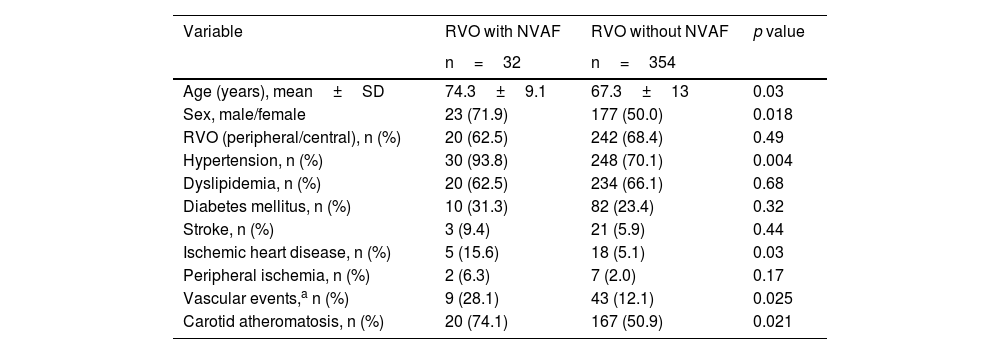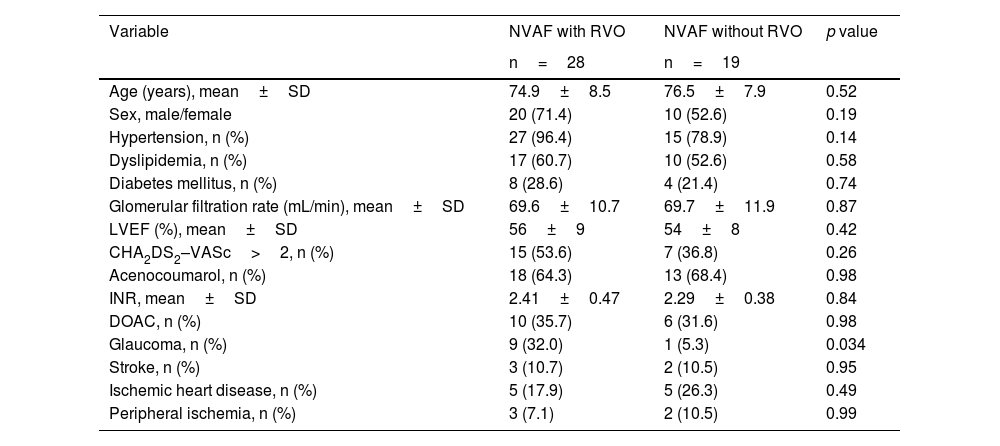Retinal vein occlusion (RVO) and nonvalvular atrial fibrillation (NVAF) are associated with vascular risk factors (VRF) and aging. The aim of this study is to analyze differences in the prevalence of VRF, vascular events, glaucoma, and anticoagulant treatment in patients with NVAF and RVO compared to a control group of the general population from the same geographic area.
MethodsThis is a prospective, single-center, case-control study. All patients diagnosed with RVO from December 2008 to March 2020 as well as a control group were included. Clinical, laboratory, electrocardiographic, and carotid ultrasound variables were analyzed.
ResultsA total of 386 patients with RVO and 343 controls were studied. Patients with RVO and NVAF were older and more of them had hypertension, a history of vascular events, and carotid atheromatosis than subjects with RVO without NVAF. In patients with NVAF who were on anticoagulants, those who had RVO differed from the controls with NVAF in that they had a higher prevalence of glaucoma (32 vs. 5.3%; p<0.034), with no significant differences regarding age, VRF, vascular events, or type of anticoagulant therapy (acenocumarol or direct-acting oral anticoagulants).
ConclusionsPatients with RVO and NVAF were older and had a higher prevalence of hypertension and carotid atheromatosis than subjects with RVO without NVAF. Patients with NVAF and RVO had higher prevalence of glaucoma than subjects with NVAF without RVO. In patients with NVAF, it is recommended to optimized VRF treatment and glaucoma control to prevent the development of RVO.
La obstrucción venosa retiniana (OVR) y la fibrilación auricular no valvular (FANV) se relacionan con los factores de riesgo vascular (FRV) y con el envejecimiento. Este trabajo tiene por objetivo analizar las diferencias en la prevalencia de los FRV, de los eventos vasculares, del glaucoma y del tratamiento anticoagulante en los pacientes con FANV y OVR comparada con un grupo control de la población general de la misma área geográfica.
MétodosEstudio prospectivo unicéntrico de casos y controles. Se incluyeron todos los pacientes diagnosticados de OVR desde diciembre de 2008 hasta marzo de 2020, y un grupo control. Se analizaron variables clínicas, de laboratorio, electrocardiográficas y de ultrasonidos de carótida.
ResultadosSe estudiaron 386 pacientes con OVR y 343 controles. Los pacientes con FANV y OVR eran de mayor edad, tenían más hipertensión, antecedente de eventos vasculares y ateromatosis carotídea que los sujetos con OVR sin FANV. En los pacientes con FANV anticoagulados, aquellos que tenían OVR, diferían de los controles con FANV en una mayor prevalencia de glaucoma (32 vs. 5,3%; p<0,034), sin hallarse diferencias significativas respecto a la edad, los FRV, los eventos vasculares o la terapia anticoagulante pautada (acenocumarol o anticoagulantes de acción directa).
ConclusionesLos pacientes con OVR y FANV tienen mayor edad y mayor prevalencia de hipertensión arterial, y ateromatosis carotídea que los que no tienen FANV. Aquellos con FANV y OVR difieren de los que no tienen OVR en la mayor incidencia de glaucoma. En los pacientes con FANV sugerimos optimizar el tratamiento de los FRV y el control del glaucoma para prevenir el desarrollo de la OVR.
Article
Diríjase desde aquí a la web de la >>>FESEMI<<< e inicie sesión mediante el formulario que se encuentra en la barra superior, pulsando sobre el candado.

Una vez autentificado, en la misma web de FESEMI, en el menú superior, elija la opción deseada.

>>>FESEMI<<<








